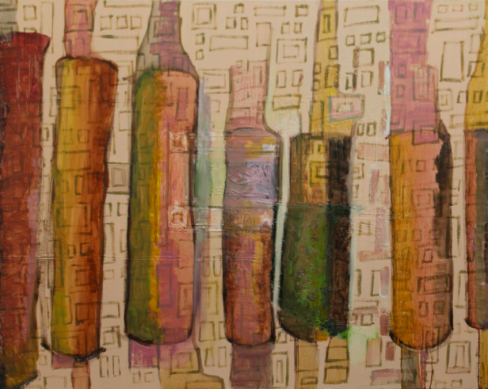This new body of works of Judy Carroll Deeley is still concerned with the word ‘paraphernalia’, whose etymological meaning comes from the ancient Greek parapherna, and then later from the medieval Latin paraphernalis. Today this word has largely assumed in English a completely different meaning, but in the past it had a clear connection with women and their conditions mainly as wives with a series of duties towards their families and especially their husbands.

Nowadays, this original meaning is almost forgotten, but it remains visible in Judy’s oeuvre since her paintings refer to the domestic interior, the space associated with the woman as housewife. However, in this new body of work, she moves from the walls of the house to the outside looking at mechanical instruments abandoned in the land.
Attracted by these ordinary objects, such as obsolete gadgets or broken and dripping pipes, Judy describes in her paintings details of abandoned industrial and agricultural plant that are disappearing in a tired but resilient nature. She is interested in the impact of these abandoned works in the environment as the consequence of the Anthropocene, a new geological epoch dominated by humanity and its capitalistic purposes. For this reason, it would be better to talk of Capitalocene or even better Plantationocene. It highlights the plantation system as a structural cause of geological transformation, from the eighteenth and nineteenth centuries. Since the Industrial Revolution, humans have had an unambiguously global impact. Our human tendency, increasingly aggressive, to create an environment for ourselves and our activities has interacted and still interacts with the natural environment, and we are unsure what the long-term consequences will be. The most predictable future will be an Earth’s surface covered with a finely engineered metal and plastic skin. As Jan Zalasiewicz announces in his book The Earth After Us. What legacy will humans leave in the rock? (Oxford University Press, 2008): “We are poisoning the planet, fowling our own earthly nest, causing ecological mayhem, producing an environmental grande crise which will not only cause our own extinction, but which will damage all present and future life on Earth beyond repair, and so put a full stop to the four-billion-year-long history of life on this planet”.
What we are leaving behind is a manmade phenomenon so massive that Earth scientists suggest it is creating a distinct geological layer upon the Earth made up of technofossils. These nonorganic materials – almost anything that is not recycled has the potential to fossilise partially or entirely – are preserved over time buried in the Earth or within layers of other fossils.
This damaged and sick nature emerges in Judy’s paintings through the depiction of everyday objects that populate our ruined landscapes. Her still lifes are connected with the theory of the readymade, or even better described by the French word objet trouvé as it describes the essence of this art manipulation: objects or industrial products with non-art function or value found wherever to become an art piece thanks to a meaningful process which generates a new background, a new sense of the art context. This generative semiotics process makes it possible to understand what Judy is currently doing in her paintings: she is appropriating the image of daily and ready-made objects as subjects of her still lifes – through which they are losing their utilitarian and descriptive function to assume a new visual and symbolic image.

As a visual artist, Judy Carroll Deeley represents through fade pigments and abstract impressions the paraphernalia that surrounds us in everyday life, but she does this in a very personal way. The apparent simplicity of the contents is enhanced by the pictorial quality. These common objects are not losing their emotional charge as had happened with the frosty readymade, but rather they are keeping their memory of a vanishing world. An often overlooked or ignored reality is represented by her reassuring warm palette which makes it poetic and surreal and, even where its subjects remain undetailed it can be seen that they do not lose their realism. Like the coeval Italian painters Giorgio Morandi and Filippo De Pisis, one famous for his still lifes and the other one for his quick brush strokes, Judy Carroll Deeley synthesises them both for their thematics and techniques. Like Morandi, she is stuck to the still life subjects, but like De Pisis she is able to trace the figures quickly on the canvas. Her mark has surely the ability to grab the transient reality and the items destined to disappear through her brushstroke.
In conclusion, the biology of this world as we know it is at the base of her present research, and it finds expression in the subject represented in every painting and through the technique that highlights the ephemerality of our life on this planet, where we leave in our wake only junk as artefacts of our existence.
Curated by Valeria Ceregini
__________________________
Paraphernalia: the word ‘paraphernalia’ suggests ‘the property which a bride possesses beyond her dowry and which she brings to the marriage’.
(The Concise Dictionary of English Etymology, 1993. Wordsworth)


